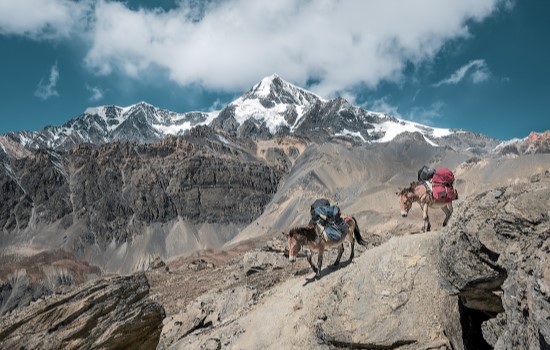“One need not go to the mountains to see them [donkeys]”, writes the author, adding, “they are noticeable in my surroundings, where high-rise construction is in full swing, assisting workers, and carrying bricks tucked inside open-mouthed gunny bags strung over their back”
 Logistics Monitor/By Ramesh Kumar
Logistics Monitor/By Ramesh Kumar
Tom Whipple* has chosen a jennet (she-donkey) to carry the load across the treacherous mountain path in Europe. That’s no surprise. Since time immemorial, donkeys have been used for carting cargo. The surprise package was Tom was on a family walk or holidaying with his two kids: 3- 5-year olds on the Alps in mid-2021. Choosing the beast of burden indeed looked strange. Quirky. So what? Tom was looking for adventure and wished to prove that family vacations need not be on the seaside villa or cruise. It can be something like this: traveling with an ass!
Nobel laureate John Steinbeck traveled across the American highways in his truck with his French poodle Charley and wrote, My Travels With Charley: In Search of America, non-fiction. A decade later, British literary giant Graham Greene penned the unforgettable lighter fiction, Travels with My Aunt detailing the experience of the fictional retired banker character traveling across Europe with Aunt Augusta.
Why go elsewhere? Remember the disputed Biblical narration of Joseph and his Jesus-bearing Mary traveling to Bethelem with a donkey in tow! In the days of the pre-motorised era, it was not uncommon to move from place to place with animals: cows, horses, and dogs. Caravanserais. But, in 2021, trekking with a donkey, even if her name is Libellule! Surprise, meaning “dragon fly” in French.
“Equus africanus” is the zoological name for an ass or donkey. They are interchangeable. For me, this burden of beasts is perfect logistic service providers (LSPs). I don’t have to go to the mountains to witness them. They are noticeable in my surroundings, where high-rise construction is in full swing, assisting workers, carrying bricks tucked inside open-mouthed gunny bags strung over their back.
China and Coronavirus are synonymous these days. If China is there, then there is the Silk Road. This man and animal-made pathway connected the East with the West, stretching thousands of miles. Over these roads, animal-drawn caravansarais and animals rode carrying goods uncomplainingly. There were donkeys predominantly then.
Do you know, there were 3,000 professional donkey-drivers in Cairo alone in the 17th century? At the height of the Silk Road era, high-value, low bulk items moved back and forth across the Alps donkey back: spices, pigments, silk, and incense northbound; wool, linen, canvas, tin, and Frankish swords southbound.
Historians point out that donkeys are portrayed to emphasise “on work or to indulge in eating, drinking and sex”. Greek proverbs project them as “inferior, obstinate, promiscuous, incapable of higher culture, and appropriate targets for physical chastisement.” Perhaps, we have imbibed the Grecians when we chastise others as “gadhe”!
Donkeys, historical records affirm, were put to use for farming too. On managing landed estates, the prescription was for three donkeys to carry manure for fertilizer to the olive groves, one to work the olive press, two to plough between the vine rows, and another for grapes pressing.
One can go on and on endlessly. By 1900 BC, not having a donkey was a sign of poverty. However, there was much more to the donkey than its just being the container truck of its day, writes University of Arizona Professor Peter Ian Kuniholm, in his review of Peter Mitchell’s ‘The Donkey in Human History: An Archaeological Perspective’ (OUP 2018).
Did donkeys predate horses? If Mitchell were to be believed, “long before the arrival of the horse, they (donkeys) were ridden by kings in the Near East, buried near Egypt’s first pharaohs…”.
One last bit of titbit. China is said to be the largest donkey breeder in the world. It uses donkey hides as an ingredient to make a traditional Chinese medicine to treat blood circulation, anaemia, and reproductive issues. Pakistan exports donkeys to China in large numbers, and a 3,000-acre donkey farm is functional in Punjab. Naila Inayat of Pakistan tweets: “Pakistan’s first donkey breeding farm in Okara. The farm has been set up in response to the rising demand for donkeys in China and other countries.”
So, next time, when you want to abuse someone as ‘gadhe’, stop and think. Better it would be if you don’t denigrate these logistic service providers since time immemorial.
Want to try taking a donkey as a travel companion during your next European holiday? Check out www.itinerance.net for embarking on donkey hikes.
(Note: The Times, London, Travel, September 11, 2021)
- The image of mountain mules by Simon Berger from Pixabay has been used for illustrative purpose only.
- Ramesh Kumar’s previous column, dated October 11, 2021, for The News Porter: Product innovation versus process innovation: Discover the difference
[The author is a business journalist specializing in logistics and supply chain. He has traveled 200,000 km on the Indian highways, met over 100,000 long-haul truck drivers across India since January 2010. He has authored three books: 10,000KM on Indian Highways, Naked Banana! and An Affair With Indian Highways. He is a Life Member of the Chartered Institute of Logistics & Transportation (CILT-India Chapter). He can be reached at konsultramesh@gmail.com. In this column, ‘Logistics Monitor’, he presents a global perspective on logistics and supply chain. The views are the author’s own and The News Porter bears no responsibility for the same.]












More Stories
When Rajesh Khanna left the shoot mid-way, told scribe, ‘I’m going for a screw’
Of the Northern Lights and an Adventure with Huskies in Swedish Lapland!
1st April question: Is April Fool’s Day indeed a fool’s day?